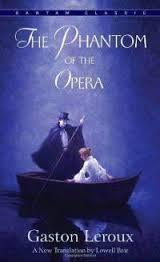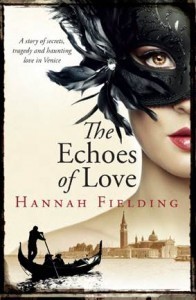Hannah Fielding's Blog, page 115
December 11, 2013
Watch my latest interview on my new novel, The Echoes of Love
Lady Caroline Blanche Elizabeth Lindsay, and her take on Venice
 Researching a novel is a real treat for a book lover like me. For my new book, The Echoes of Love, I plunged myself into all manner of reading material on Italy and the specific places in which I situate the narrative: Tuscany, Sardinia and, of course, Venice. Poetry, in particular, inspired me – indeed it always has, since my childhood, when my parents introduced me to classic works, and through my French Literature degree. Poets have a such a way of creating the feel for a place in the mind through the rhythms and vocabulary and syntax they employ.
Researching a novel is a real treat for a book lover like me. For my new book, The Echoes of Love, I plunged myself into all manner of reading material on Italy and the specific places in which I situate the narrative: Tuscany, Sardinia and, of course, Venice. Poetry, in particular, inspired me – indeed it always has, since my childhood, when my parents introduced me to classic works, and through my French Literature degree. Poets have a such a way of creating the feel for a place in the mind through the rhythms and vocabulary and syntax they employ.
One of the poets whose work I most enjoyed in my research was Lady Caroline Blanche Elizabeth Lindsay (see here for a picture). Born in 1844, Lady Lindsay was the daughter of the British politician Henry Fitzroy and she grew up to marry Sir Coutts Lindsay, who was an artist and twenty years her senior. Together with her husband, she set up the Grosvenor Gallery in 1877, which was very important in the Aesthetic Movement and provided a sanctuary for some great artists whose works the Royal Academy did not appreciate.
According to the correspondence of James Whistler, she was ‘the epitome of the cultured and fashionable aesthetic woman’. Clearly a very artistic lady, Lady Lindsay did dabble in painting (and in playing the violin), but she was a writer at heart. Shortly after founding the Grosvenor Gallery, just four years since getting married, she and Sir Lindsay parted company, and literature must have been a source of solace for her as she lived out the remainder of her life alone.
Lady Lindsay wrote some novels, but it was in the area of poetry that she was most prolific. Her collection From a Venetian Balcony: And Other Poems contains a wealth of verses on Venice that transport you to the ancient city. Today I’m sharing one of my favourites, more a song than a poem, which somehow always leaves me craving a punnet of ripe, sweet cherries…
Bar Carol
In the June-tide, in the June-tide,
In the sweet and summer noon-tide,
From Murano,
From Burano,
And from far high-towered Torcello,
Come the wherries,
Filled with cherries,
Flaunting sails of russet yellow,
Floating onward, silent, gliding
As by magic measure sliding,
Drifting o’er the silver sea.
In the June-tide, in the june-tide,
In the sweet and summer noon-tide,
When a certain boatman ferries
Venice-ward his freight of cherries-
Marco’s on his way to me.
December 9, 2013
Book review: Christmas at Angel Lake by Edie Ramer
From the blurb:
A kitten saved her…
Broke, pregnant and deserted by her boyfriend, Maddie Barrymore swerves to avoid a kitten while driving in a Wisconsin blizzard—and her life takes another turn. Like Puss in Boots, she stays in an empty house. She has the baby, the kitten, gets a job and a degree…yet every day she’s ready to flee if the real owner shows up.
Five years later, he does…
Dumped by the woman he loves, film producer Logan MacLeesh’s heart is as dark as one of his movies. He plans to hole up in his grandmother’s old mansion and throw himself into his work…until he discovers the sexy squatter and her four-year-old son. Before he can call the sheriff, Maddie’s tale of how she ended up there entertains him. They make a deal that as long as she tells him a story every night, she and her son can stay. Even the cat, though Logan’s always been a dog person.
A dog in need of saving…
Far away in another state, a homeless dog lifts his head, sniffs…and smells him . The human who’s meant for him. As he heads through the snow toward the scent, his journey seems impossible, even though it’s Christmas, a time when miracles happen.
I requested this book from NetGalley because I really liked two elements of the premise: squatter and landlord, an interesting new angle for romance; and the deal that Maddie will tell Logan a story each day, which is right up my street (a similar deal I made in my childhood made me the writer I am today, after all!).
I enjoyed the central story – how Maddie and Logan grow close to each other over the course of the book; how Logan learns to let go of his painful past; how Maddie gives herself permission to fall in love; and, finally, how Maddie does battle over her job, with a little support from Logan.
But for me, the best parts of the book are:
1. The sharp, witty dialogue, which really brings the characters to life. There’s a lot of banter, which made me like the characters – although I did wonder how they were quite so comfortable with each other so quickly.
2. The stories that Maddie tells. Her very squatting is inspired by a fairytale (Puss in Boots), and the author expertly retells fairytales in a way that allows the characters to explore their pasts and their futures – a fresh, novel and engaging medium.
I have to confess, I wasn’t overly engaged with the dog point of view in the book, but if you’re a reader who loves cats and dogs, I’m sure this element of the book will be most appealing. Certainly, the ending is a happy one all round that gives that warm glow.
It’s a book set around Christmas time, but don’t let that mean you could only read it then – the Christmas element doesn’t overpower this being a good romance story (with plenty of stories within the narrative to add interest).
A warm, witty, cleverly executed book for readers who like spirit, sass and unconventional romance with a twist of good, old-fashioned connection.
I was offered this book in exchange for a fair review via NetGalley.
Christmas at Angel Lake is available now from Amazon; click on the book cover below to visit the store.
December 8, 2013
Sardinian Recipe: Pane Carasau
 In my book The Echoes of Love, the hero, Paolo, and the heroine, Venetia, escape to the island of Sardinia for some much needed time together. There, they sample a range of the local cuisine, including pane carasau.
In my book The Echoes of Love, the hero, Paolo, and the heroine, Venetia, escape to the island of Sardinia for some much needed time together. There, they sample a range of the local cuisine, including pane carasau.
Pane carasau is a traditional Sardinian flatbread whose recipe dates back a long way (it has been found in excavations on the island dated earlier then 1000 BC). The breads lasts, amazingly, for up to one year if kept dry, which is why it was ideal in ancient times for shepherds on the island who would be away from home for months.
The pane is known for two key qualities: thickness and crispiness. It’s usually baked in a large dish, up to fifty centimetres wide, and then split into two very thin sheets that are re-baked for extra crunch (so that the bread is like a cracker in consistency).
Pane carasau is also known as carta di musica for its resemblance to paper (a music sheet). Indeed, after cooking the bread is so thin you can see through it!
The bread is highly versatile – it can be eaten as it is, dry; dipped into wine or sauces, or combined into a main-meal dish, such as pane frattau, when the bread is combined with eggs, tomato sauce, olive oil and pecorino cheese (a kind of rustic pizza).
Here’s a simple recipe you can try at home.
Ingredients
1 1/2 cups plain flour
1 1/2 cups semolina flour
1 1/2 cups warm water
1 tablespoon dried yeast
1 teaspoon fine salt
1. Sift together the flours and the salt.
2. Dissolve the yeast in some of the water and leave until bubbling.
3. Stir the yeast into the flours and salt and add the rest of the water.
4. Mix well (a mixer comes in handy here). Knead lightly.
5. Leave to rise, covered, for an hour.
6. Knead thoroughly and divide into balls.
7. Grease flat baking trays with olive oil.
8. Roll out the balls to make thin rounds (thin as you can!) and place on the trays. (Depending on the size of your oven, you may need to bake in batches).
9. Bake in a preheated oven (475 F/ 225 C) for a 5 minutes, turning halfway.
10. Remove from oven. (For extra crunch, allow to cool and then repeat step 9 – bake again.)
Serve sprinkled with seasoning, such as paprika or sea salt, or alongside a dish as a dipper. Enjoy!
December 6, 2013
Commedia dell’arte
 Have you heard of the classic theatre form called Commedia dell’arte . It began back in the 16th century, and it has two key characteristics: the use of improvisation in pieces (its full name is commedia dell’arte all’improvviso, comedy through the art of improvisation), and the incorporation of masked characters playing certain roles. The use of masks in the Commedia dates back to the 1570s and the city of Venice: no wonder, then, that the Venetian Carnival so embraces the wearing of masks.
Have you heard of the classic theatre form called Commedia dell’arte . It began back in the 16th century, and it has two key characteristics: the use of improvisation in pieces (its full name is commedia dell’arte all’improvviso, comedy through the art of improvisation), and the incorporation of masked characters playing certain roles. The use of masks in the Commedia dates back to the 1570s and the city of Venice: no wonder, then, that the Venetian Carnival so embraces the wearing of masks.
The Commedia was wildly popular, to the point that patrons would sponsor troupes and those acting in troupes gained celebrity status. Certain stock characters evolved, which meant audiences coming to see the Commedia were familiar enough with the format but enjoyed being surprised by the story created there and then by the actors. Many kinds of stories were told through the Commedia medium, but the most common plot was young lovers falling in love and being thwarted by the vecchi (the older ones, the masters), leading to comical and crazy servants intervening to ‘help’ and, ultimately, a happy ending. With the masks occluding expressions, speech and physical movement were important and exaggerated. Many performances incorporated song and dance, and well-known jokes and slapstick physical humour.
Characters fall into three camps: servants or clowns (zanni), masters/villains (vecchi) and lovers (innamorati). Each character had its own defining characteristics: a way of speaking, gestures, plots, attire and, of course, the mask. The following specific roles have become well known:
Pantalone, a wealthy but miserly Venetian merchant. Dresses in red with a large, red-nosed mask.
Il Dottore, Pantalone’s neighbour from Bologna. Either close friend or bitter enemy of Pantalone. Pompous and feigns being educated. Wears a black mask.
Il Capitano, an arrogant Spanish captain. Full of faux bravado. Wears lots of colour.
Inamorati, the young lovers. The only characters who don’t wear masks.
Arlecchino, a mischievous servant, also known as Harlequin. Wears a multicoloured outfit and a black mask.
Columbina, a clever and beguiling servant who’s often paired with Arlecchino.
Brighella, a dastardly merchant. His mask is green.
Pulcinella, a wife-beating servant (the model for the later Punch of Punch and Judy in England). His mask is black with a long nose.
For more details on the Commedia characters, see https://sites.google.com/site/italiancommedia/the-characters and http://www.metmuseum.org/toah/hd/comm/hd_comm.htm. In addition, this video gives an idea of the costumes and mannerisms of some of the main characters:
Many of the Commedia masks feature in the Venice Carnival. For details and images of the masks, visit http://www.magicofvenezia.com/servlet/the-template/maskstory/Page.
December 5, 2013
PUBLICATION DAY FOR MY NEW BOOK, THE ECHOES OF LOVE!
I simply couldn’t let the day go by without doing my version of ‘shouting it from the rooftops’:
My second novel, The Echoes of Love, officially publishes today!
A new setting – romantic and mysterious.
A new story – passionate and twisting.
A new heroine – strong and conflicted.
A new hero – handsome and tortured.
A new obstacle – dark and dangerous.
And a new reason to curl up in an armchair, cosseted from the cold winter, and lose yourself in a world of romance like Hollywood used to make!
I so enjoyed writing this romance, and I do hope you enjoy reading it! Keep an eye on the blog for plenty of background on the novel coming in the next few months. And if you are a book blogger or like to review books for Amazon and Goodreads and would like a free copy of the novel , just get in touch.
My house in Kent on a sunny autumn day
December 3, 2013
Favourite writer: Gaston Leroux
 My university degree was in French Literature, so it was inevitable that I would read the works of French journalist Gaston Leroux.
My university degree was in French Literature, so it was inevitable that I would read the works of French journalist Gaston Leroux.
Leroux (1868–1927) was a born and bred Parisian with a near-encyclopedic knowledge of his home city, gleaned through years working as a court reporter and theatre critic for L’Écho de Paris. He dedicated the last 20 years of his life to writing fiction, during which time he wrote a mystery novel, The Mystery of the Yellow Room, introducing the character Joseph Rouletabille, amateur detective, who for the French is on a level with Sherlock Holmes.
But it is for The Phantom of the Opera that Leroux is best remembered. From the Collins Classic edition blurb:
‘Look! You want to see! See! Feast your eyes, glut your soul on my cursed ugliness! Look at Erik’s face! Now you know the face of the voice!’
Living secretly beneath the Paris Opera House, ‘The Phantom of the Opera’, Erik has haunted those who work there with his demands and shrouded the opera house in fear with the legend of his disfigured face. When Christine joins the company, a young woman with a beautiful voice, Erik is instantly smitten and secretly teaches her to become a great singer. He soon develops an obsessive love for his beautiful protégé, even though she has fallen for her childhood friend, resulting in her disappearance during a performance and sparking a tragic and terrifying chain of events.
One of the most well-known and well-loved gothic horror stories, Leroux’s suspenseful tale of unrequited love, passion and tragedy is both dark and moving in its portrayal of Erik, the anti-hero in his yearning for Christine.
Leroux’s story has captured imaginations for more than one hundred years now – from filmmakers to theatre producers, musicians to novelists – for good reasons:
The dramatic, visual quality of the writing: Leroux had set up a film company with a friend, and he wrote quite deliberately in the hope of his novels being brought to the big screen.
The realism of the setting: Leroux knew the Paris Opera House well, and had even covered a court case in which the premises were investigated thoroughly. He’d explored carefully, and had seen prisoners in the basement, held for the Paris Commune, which no doubt fired up his imagination.
The grande romance of the story: A classic love triangle, with a girl torn between stability and excitement, love and passion, security and danger, simplicity and a compassionate desire to heal, to help, to forgive, to rescue.
The pace: This book is a thoroughly good read, with plenty of action and excitement and twists to keep any reader on their toes.
The layers of meaning within the narrative, and the resounding messages that come through: This is not just a story; this is an exploration of the definitions of beauty and desire and possession, and of the consequences when a society rejects and ostracises one of their own.
For me, it is the last element that is the most powerful. So many lines in the book jump out as being poignant and moving:
‘If I am the phantom, it is because man’s hatred has made me so. If I am to be saved it is because your love redeems me.’
‘You are crying! You are afraid of me! And yet I am not really wicked. Love me and you shall see! All I wanted was to be loved for myself.’
‘None will ever be a true Parisian who has not learned to wear a mask of gaiety over his sorrows and one of sadness, boredom, or indifference over his inward joy.’
‘Poor, unhappy Erik! Shall we pity him? Shall we curse him? He asked only to be ‘some one,’ like everybody else. But he was too ugly! And he had to hide his genius or use it to play tricks with, when, with an ordinary face, he would have been one of the most distinguished of mankind! He had a heart that could have held the entire empire of the world; and, in the end, he had to content himself with a cellar. Ah, yes, we must need pity the Opera ghost…’
A key concept in The Phantom is masks – what they symbolise, what lies beneath. Disguise and deceit are also fundamental in my new novel The Echoes of Love, which is set in Venice, city of contradictions, and opens during the Carnival in which Venetian masks abound – hence as I polished The Echoes of Love ready for publication, I found myself drawn to Gaston Leroux’s work once more.
In an earlier blog post I shared the Masquerade scene from the most recent film version of The Phantom of the Opera. Today, I’m sharing the scene in which the Phantom is unmasked – which is horrifying and moving in equal measure.
Soon on this blog I will be dedicated a series of blogs to masks, so check back for plenty more romance, intrigue and a history of the famous Venetian masks.
December 2, 2013
A signature tune for my new novel
Whenever I’m writing a book, I create a playlist of music that transports me to the time and place and feeling of the novel. For The Echoes of Love, my next novel that will publish on 6 December, I very much enjoyed immersing myself in Italian music, especially the romantic songs.
Today, I’m sharing with you one of the songs that features twice in the book, at times of great emotional impact for my hero, Paolo, and heroine, Venetia: once during their first chance encounter, and the next time when they dance. It is, if you like, their song, symbolic of how the world falls away when they are together. The song is ‘Il Cielo in una Stanza’, sung by Mina, which translates to ‘The Sky in a Room’. I love the opening:
Quando sei qui con me
questa stanza non ha più pareti
ma alberi,
alberi infiniti
quando sei qui vicino a me
questo soffitto viola
no, non esiste più.
Io vedo il cielo sopra noi
When you are here with me
This room doesn’t have walls any more
But trees
Infinite trees
When you are here near me
This ceiling breaks
No, it doesn’t exist any more.
I see the sky above us
Mina, ‘Il Cielo in una Stanza’ (1960)
December 1, 2013
National Novel Writing Month (NaNoWriMo): Author’s friend or foe?
 November has come to an end, and with it National Novel Writing Month, known in the industry as NaNoWriMo. The concept is simple: writers across the world alike sit down during the month of November and write 50,000 words of a novel. The project is immensely popular, with 307,000 authors signing up for the 2013 run – professionals and amateurs alike. (One of the best success stories is Sara Gruen’s Water for Elephants, which was made into a movie starring Robert Pattinson and Reese Witherspoon.)
November has come to an end, and with it National Novel Writing Month, known in the industry as NaNoWriMo. The concept is simple: writers across the world alike sit down during the month of November and write 50,000 words of a novel. The project is immensely popular, with 307,000 authors signing up for the 2013 run – professionals and amateurs alike. (One of the best success stories is Sara Gruen’s Water for Elephants, which was made into a movie starring Robert Pattinson and Reese Witherspoon.)
NaNoWriMo is a brilliant project for several reasons:
It has earned worldwide recognition and respect.
Those participating become part of a wide community – and there are lots of opportunities for making new friends and contacts online as part of your writing work.
The project offers a ready-to-go structure for your writing. However you break down the work, to succeed you must hit that 50,000-word mark by 30 November. It equates to 1,667 words per day.
The pressure, the challenge, the sense of belonging – all these, and more, contribute to a drive for the writer to write, write, write, thereby forcing you past procrastination and blocks and into a place of pure creativity.
The result – 50,000 words – can form the basis for a book that you then go on and develop, with a sense of relief that you already have the bare bones down on paper.
So with such compelling advantages, why isn’t every author, aspiring or established, across the globe diving in to NaNoWriMo each November?
Time, first and foremost, can be an issue. The target of 1,667 words per day – or 12,500 words per week – perhaps looks, on paper, to be manageable. But during the month most writers must also hold down the day job and juggle family commitments. Some writers are faster than others; some really struggle to meet the targets, and then become depressed at what they perceive as ‘failure’.
Pressure can be just what you need to get moving on that book you’ve long dreamt of writing. When the clock is ticking, you have no time for doubt – you’d better just get writing. But that pressure can be too much for some writers, who prefer to take time over their writing.
Writing approach is also a big factor in whether you embrace NaNoWriMo or give it a wide berth. If you’re a writer who likes to bash out a quick first draft, the rough foundation for the book, and then come back and develop it then NaNoWriMo gets your project moving quickly. But if you prefer to perfect each chapter before moving on, and the quality of that first draft really matters to you, NaNoWriMo is likely to be a source of stress rather than accomplishment.
Personally, I think NaNoWriMo is a wonderful initiative: any project that encourages people who want to write to sit down and go for it is to be commended, and any writer who manages to complete the target deserves praise. As long as writers participating realise that the 50,000-word draft that is the end result of NaNoWriMo is just that – a draft, and not a polished book ready for publication – then the project is going a long way to helping so many writers break the back of their book-writing each year.
I’ll confess, speed writing in this way is not for me. I take several months to write a novel, having researched and planned it thoroughly, and I very much need the sense that what I’ve written thus far is of a certain quality before I can continue writing. I do, however, follow a similar discipline to the NaNoWriMo process: I break down the task of writing a book, I set small targets to reach and then I schedule my days carefully to ensure I am keeping on track.
How about you? Have you taken part in NaNoWriMo? Would you? Do you think there is something to be said for writing fast and then tidying later? I would love to hear your thoughts.
To find out more about NaNoWriMo, and to sign up and explore the community, visit http://nanowrimo.org/.








